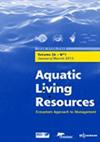Population structure, reproduction and exploitation of the greater forkbeard Phycis blennoides (Brünnich, 1768) from the Algerian basin★
IF 1.5
4区 农林科学
Q3 FISHERIES
引用次数: 0
Abstract
The objective of this study was to determine the population distribution and some biological aspects for fish stock assessment of the greater forkbeard Phycis blennoides along the Algerian basin. The distribution of P. blennoides (3418 individuals) was studied using data collected between 170–779 m depth during two bottom trawl surveys developed on 2003 and 2004. Additionally, some biological parameters were obtained from 1050 individuals sampled from commercial fisheries in Algerian ports (i.e. Annaba, Azeffoun, Dellys, Cap Djinet, Zemmouri, Bouharoun, Algiers, La Madrague, Cherchell, Tenes and Mostaganem) during the period 2013–2017. P. blennoides sampled from bottom trawl surveys showed a depth related distribution with the largest individuals being found at 600–800 m depth and the smallest at shallower depths. Density and biomass varied with depth and density also with longitude, while biomass showed no pattern with longitude. Recruitment was recorded in the eastern sector of Algeria during winter, for individuals sampled by bottom trawl surveys. Young P. blennoides entered commercial fisheries in summer, with an overall sex ratio skewed towards males (1F:2.18M). The size at first maturity (L 50) was 24.30 cm and 30.39 cm for males and females, respectively. The age at 50% maturity was 2–3 years for specimens collected by a bottom trawl survey in 2003 and commercial fisheries, but 3–4 years for the bottom trawl survey in 2004.
阿尔及利亚盆地大叉叉叶藻(br nnich, 1768)的种群结构、繁殖和开发★
本研究的目的是确定阿尔及利亚盆地大叉须blennoides的种群分布和鱼类资源评价的一些生物学方面。利用2003年和2004年进行的两次海底拖网调查,在170 ~ 779 m深度范围内收集资料,研究了黄颡鱼(3418只)的分布。此外,在2013-2017年期间,从阿尔及利亚港口(即安纳巴、阿泽富恩、德利斯、吉奈角、泽穆里、布哈龙、阿尔及尔、拉马拉格、谢尔切尔、特内斯和莫斯塔加内姆)的商业渔业取样的1050只个体中获得了一些生物学参数。从海底拖网调查中得到的双头鱼的分布与深度有关,最大的个体出现在600-800 m深度,最小的个体出现在较浅的深度。密度和生物量随深度变化,密度随经度变化,生物量随经度变化无明显规律。在阿尔及利亚东部地区,通过底部拖网调查对个体进行了冬季招募记录。幼鱼在夏季进入商业渔场,总体性别比例向雄性倾斜(1F:2.18M)。雄、雌初成熟时(l50)大小分别为24.30 cm和30.39 cm。2003年海底拖网调查和商业渔业收集的标本在50%成熟时的年龄为2-3年,而2004年海底拖网调查收集的标本在50%成熟时的年龄为3-4年。
本文章由计算机程序翻译,如有差异,请以英文原文为准。
求助全文
约1分钟内获得全文
求助全文
来源期刊

Aquatic Living Resources
农林科学-海洋与淡水生物学
CiteScore
2.30
自引率
0.00%
发文量
10
审稿时长
>24 weeks
期刊介绍:
Aquatic Living Resources publishes original research papers, review articles and propective notes dealing with all exploited (i.e. fished or farmed) living resources in marine, brackish and freshwater environments.
Priority is given to ecosystem-based approaches to the study of fishery and aquaculture social-ecological systems, including biological, ecological, economic and social dimensions.
Research on the development of interdisciplinary methods and tools which can usefully support the design, implementation and evaluation of alternative management strategies for fisheries and/or aquaculture systems at different scales is particularly welcome by the journal. This includes the exploration of scenarios and strategies for the conservation of aquatic biodiversity and research relating to the development of integrated assessment approaches aimed at ensuring sustainable and high quality uses of aquatic living resources.
 求助内容:
求助内容: 应助结果提醒方式:
应助结果提醒方式:


